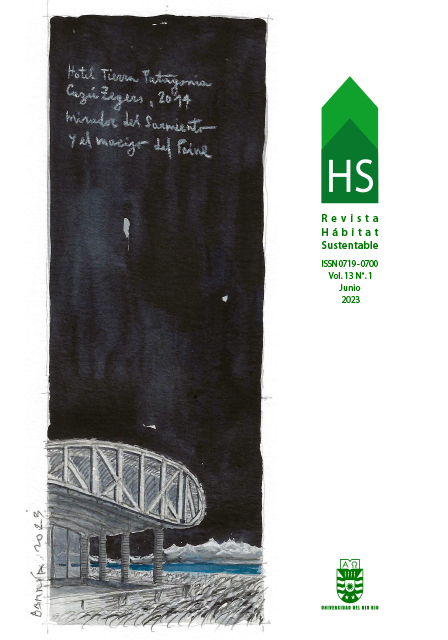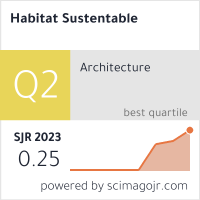Efectividad a futuro de las estrategias de diseño pasivas en viviendas
DOI:
https://doi.org/10.22320/07190700.2023.13.01.03Palabras clave:
cambio climático, arquitectura sustentable, viviendas unifamiliaresResumen
Las estrategias de diseño arquitectónico pasivo han sido una respuesta efectiva a la crisis energética del siglo XX. En climas templados, su integración resulta en comportamientos térmicos en los que se combinan el confort interior y la eficiencia energética. Sin embargo, los escenarios de cambio climático proyectados a futuro no ofrecerán los mismos rendimientos, resultando dichas estrategias menos efectivas. El objetivo de este trabajo es la cuantificación del cambio relativo en la efectividad de las estrategias de diseño pasivas en viviendas para clima árido templado-frío (Bwk), tomando como ejemplo la ciudad de Mendoza (Argentina). Respecto delas proyecciones de clima futuro para clima árido cálido (Bwh), utilizando el escenario RCP8.5 del CMIP5, equivalente al escenario SSP85 del CMIP6 del IPCC, los resultados muestran una disminución del 20% en la cantidad de horas en confort anual, con un incremento del 24% en la necesidad de estrategias pasivas de verano.
Descargas
Citas
AGOSTA, E., ARANEO, D., CAMILLONI, I., CARRIL, A., DOYLE, M., FRUMENTO, O., NUÑEZ, M., ORTIZ DE ZÁRATE, M., PENALBA, O., RUSTICUCCI, M., SAULO C. & SOLMAN. S. (2015). Tendencias y Proyecciones: Centro de Investigaciones del Mar y la Atmósfera (CIMA). En Tercera Comunicación Nacional sobre Cambio Climático. Secretaría de Ambiente y Desarrollo Sustentable de la Nación.
BAREA, G., MERCADO, M. V., FILIPPÍN, C., MONTEOLIVA, J. M. & VILLALBA, A. (2022). New paradigms in bioclimatic design toward climatic change in arid environments. Energy and Buildings, 266, 112100. DOI: https://doi.org/10.1016/j.enbuild.2022.112100
Base de Datos Climáticos. (2022). 3ra Comunicación Nacional de la República Argentina a la Convención Marco de las Naciones Unidas sobre Cambio Climático (3CN CIMA). Recuperado de: http://3cn.cima.fcen.uba.ar/
BHAMARE, D. K., RATHOD, M. K. & BANERJEE, J. (2019). Passive cooling techniques for building and their applicability in different climatic zones—The state of art. Energy and Buildings, 198, 467–490. DOI: https://doi.org/10.1016/j.enbuild.2019.06.023
BI, D., DIX, M., MARSLAND, S., O’FARRELL, S., SULLIVAN, A., BODMAN, R., LAW, R., HARMAN, I., SRBINOVSKY, J., RASHID, H. A., DOBROHOTOFF, P., MACKALLAH, C., YAN, H., HIRST, A., SAVITA, A., DIAS, F. B., WOODHOUSE, M., FIEDLER, R. & HEERDEGEN, A. (2020). Configuration and spin-up of ACCESS-CM2, the new generation Australian Community Climate and Earth System Simulator Coupled Model. Journal of Southern Hemisphere Earth System Science, 70(1), 225–251. DOI: https://doi.org/10.1071/es19040
BRAGER, G. S. & DE DEAR, R. J. (1998). Thermal adaptation in the built environment: a literature review. Energy and Buildings, 27(1), 83–96. DOI: https://doi.org/10.1016/s0378-7788(97)00053-4
CHALMERS, P. (2015). Cambio climático: Implicaciones para los Edificios. Hallazgos claves del Quinto informe de evaluación del IPCC [Revisión del Quinto Informe de Evaluación del Grupo Intergubernamental de Expertos sobre el Cambio Climático]. University of Cambridge.
CLARKE, J., STRACHAN, P. & PERNOT, C. E. E. (1993). Approach to the calibration of building energy simulation models. En: ASHRAE Transactions 99, 13.
CORONATO, T., CARRIL, A. F., ZANINELLI, P. G., GILES, J., RUSCICA, R., FALCO, M., SÖRENSSON, A. A., FITA, L., LI, L. Z. X. & MENÉNDEZ, C. G. (2020). The impact of soil moisture–atmosphere coupling on daily maximum surface temperatures in Southeastern South America. Climate Dynamics, 55, 2543-2556. DOI: https://doi.org/10.1007/s00382-020-05399-9
ELIAS, S. A. (2017). Editor’s Note. En: Reference Module in Earth Systems and Environmental Sciences. Encyclopedia of the Anthropocene, 1, 227–231. DOI: https://doi.org/10.1016/B978-0-12-809665-9.05958-9
FALCO, M., CARRIL, A. F., MENÉNDEZ, C. G., ZANINELLI, P. G. & LI, L. Z. X. (2019). Assessment of CORDEX simulations over South America: added value on seasonal climatology and resolution considerations. Climate Dynamics, 52, 4771–4786. DOI: https://doi.org/10.1007/s00382-018-4412-z
FLORES-LARSEN, S., FILIPPÍN, C. & BAREA, G. (2019). Impact of climate change on energy use and bioclimatic design of residential buildings in the 21st century in Argentina. Energy and Buildings, 184, 216–229. DOI: https://doi.org/10.1016/j.enbuild.2018.12.015
FLORES-LARSEN, S. & FILIPPÍN, C. (2021). Energy efficiency, thermal resilience, and health during extreme heat events in low-income housing in Argentina. Energy and Buildings, 231, 110576. DOI: https://doi.org/10.1016/j.enbuild.2020.110576
GANEM, C. & BAREA, G. (2021). A methodology for assessing the impact of climate change on building energy consumption. En: Urban Microclimate Modelling for Comfort and Energy Studies. Editorial Springer. ISBN 978-3-030-65420-7
JENTSCH, M. F., BAHAJ, A. S. & JAMES, P. A. B. (2008). Climate change future proofing of buildings—Generation and assessment of building simulation weather files. Energy and Buildings, 40(12), 2148–2168. DOI: https://doi.org/10.1016/j.enbuild.2008.06.005
KOŠIR, M. & PAJEK, L. (2017). BcChart v2.0 – A Tool for Bioclimatic Potential Evaluation. Proceedings of SWC2017/SHC2017.
KOŠIR, M. (2018). BcChart v2.1. University of Ljubljana, Faculty of Civil and Geodetic Engineering.
KOŠIR, M. (2019). Climate Change and Its Implications for Bioclimatic Design. En: Climate Adaptability of Buildings , 197–236. Springer International Publishing.
KOTTEK, M., GRIESER, J., BECK, C., RUDOLF, B. & RUBEL, F. (2006). World Map of the Köppen-Geiger climate classification updated. Meteorologische Zeitschrift, 15(3), 259–263. DOI: https://doi.org/10.1127/0941-2948/2006/0130
LACAZE, L., ZAMPELLI, R., ESTAYNO, S. & BRAUDE, H. (2021). Tecnologías para la eficiencia energética residencial y la reducción de emisiones de gases de efecto invernadero. Criterios de política pública para su priorización y marco de propuestas para su desarrollo y adopción en el contexto argentino. Documentos de Trabajo del CCE N° 14. Consejo para el Cambio Estructural - Ministerio de Desarrollo Productivo de la Nación.
LI, D. H. W., YANG, L. & LAM, J. C. (2012). Impact of climate change on energy use in the built environment in different climate zones – A review. Energy, 42(1), 103–112. DOI: https://doi.org/10.1016/j.energy.2012.03.044
LÓPEZ-FRANCA, N., ZANINELLI, P. G., CARRIL, A. F., MENÉNDEZ, C. G. & SÁNCHEZ, E. (2016). Changes in temperature extremes for 21st century scenarios over South America derived from a multi-model ensemble of regional climate models. Climate Research, 68(2–3), 151–167. DOI: https://doi.org/10.3354/cr01393
LORENZ, R., PITMAN, A. J., DONAT, M. G., HIRSCH, A. L., KALA, J., KOWALCZYK, E. A., LAW, R. M. & SRBINOVSKY, J. (2014). Representation of climate extreme indices in the ACCESS1.3b coupled atmosphere–land surface model. Geoscientific Model Development, 7(2), 545–567. DOI: https://doi.org/10.5194/gmd-7-545-2014
Naciones Unidas (ONU), Acuerdo de París de la Convención Marco de las Naciones Unidas sobre el Cambio Climático (UNFCCC), 12 Diciembre 2015.
O’NEILL, B. C., TEBALDI, C., VAN VUUREN, D. P., EYRING, V., FRIEDLINGSTEIN, P., HURTT, G., KNUTTI, R., KRIEGLER, E., LAMARQUE, J.-F., LOWE, J., MEEHL, G. A., MOSS, R., RIAHI, K. & SANDERSON, B. M. (2016). The Scenario Model Intercomparison Project (ScenarioMIP) for CMIP6. Geoscientific Model Development, 9(9), 3461–3482. DOI: https://doi.org/10.5194/gmd-9-3461-2016
OLGYAY, V. (1963). Design with Climate: Bioclimatic Approach to Architectural Regionalism. Princeton University Press.
RUBIO-BELLIDO, C., PULIDO-ARCAS, J. A. & URETA-GRAGERA, M. (2015). Aplicabilidad de estrategias genéricas de diseño pasivo en edificaciones bajo la influencia del cambio climático en Concepción y Santiago, Chile. Revista Hábitat Sustentable, 5(2), 33–41. Recuperado de: https://revistas.ubiobio.cl/index.php/RHS/article/view/2106
RUÍZ-GONZÁLEZ, M. A. & MACK-VERGARA, Y. L. (2022). Indicadores de resiliencia y sostenibilidad para la vivienda urbana panameña frente al cambio climático. Revista Hábitat Sustentable, 12(2), 08–25. DOI: https://doi.org/10.22320/07190700.2022.12.02.01
SÁNCHEZ-GARCÍA, D., RUBIO-BELLIDO, C., MARRERO MELÉNDEZ, M., GUEVARA-GARCÍA, F. J. & CANIVELL, J. (2017). El control adaptativo en instalaciones existentes y su potencial en el contexto del cambio climático. Revista Hábitat Sustentable, 7(2), 06–17. DOI: https://doi.org/10.22320/07190700.2017.07.02.01
Servicio Meteorológico Nacional Argentino. (2022). Informe especial n°3 por ola de calor / altas temperaturas temporada 2022-2023.
Servicio Meteorológico Nacional Argentino. (2023a). Informe especial n°5 por ola de calor / altas temperaturas temporada 2022-2023.
Servicio Meteorológico Nacional Argentino. (2023b). Informe especial n°8 por ola de calor / altas temperaturas temporada 2022-2023.
STONE, K. A., MORGENSTERN, O., KAROLY, D. J., KLEKOCIUK, A. R., FRENCH, W. J., ABRAHAM, N. L. & SCHOFIELD, R. (2016). Evaluation of the ACCESS – chemistry–climate model for the Southern Hemisphere. Atmospheric Chemistry and Physics, 16(4), 2401–2415. DOI: https://doi.org/10.5194/acp-16-2401-2016
V., R. (2020). Una apuesta por la renovación urbana. Ediciones EL PAÍS S.L. [29 septiembre]. Recuperado de: https://elpais.com/economia/2020-09-29/una-apuesta-por-la-renovacion-urbana.html
ZIEHN, T., CHAMBERLAIN, M. A., LAW, R. M., LENTON, A., BODMAN, R. W., DIX, M., STEVENS, L., WANG, Y.-P. & SRBINOVSKY, J. (2020). The Australian Earth System Model: ACCESS-ESM1.5. Journal of Southern Hemisphere Earth System Science, 70(1), 193–214. DOI: https://doi.org/10.1071/es19035
Descargas
Publicado
Cómo citar
Número
Sección
Licencia
Derechos de autor 2023 Gustavo Javier Barea Paci, Carolina Ganem Karlen, Maria Cecilia Molina, Pia Mateo

Esta obra está bajo una licencia internacional Creative Commons Atribución-CompartirIgual 4.0.
El contenido de los artículos que se publican en cada número de Hábitat Sustentable, es responsabilidad exclusiva de los autores y no representan necesariamente el pensamiento ni comprometen la opinión de la Universidad del Bío-Bío.
Los autores/as conservarán sus derechos de autor y garantizarán a la revista el derecho de primera publicación de su obra, el cuál estará simultáneamente sujeto a la Licencia de Reconocimiento de Creative Commons CC BY-SA que permite a otros compartir-copiar, transformar o crear nuevo material a partir de esta obra con fines no comerciales, siempre y cuando se reconozcan la autoría y la primera publicación en esta revista, y sus nuevas creaciones estén bajo una licencia con los mismos términos.











 Programa de Información Científica/Concurso Fondos de Publicación de Revistas Científicas 2018/ Proyecto Mejoramiento de Visibilidad de Revistas UBB (Código:FP180007)
Programa de Información Científica/Concurso Fondos de Publicación de Revistas Científicas 2018/ Proyecto Mejoramiento de Visibilidad de Revistas UBB (Código:FP180007) 





